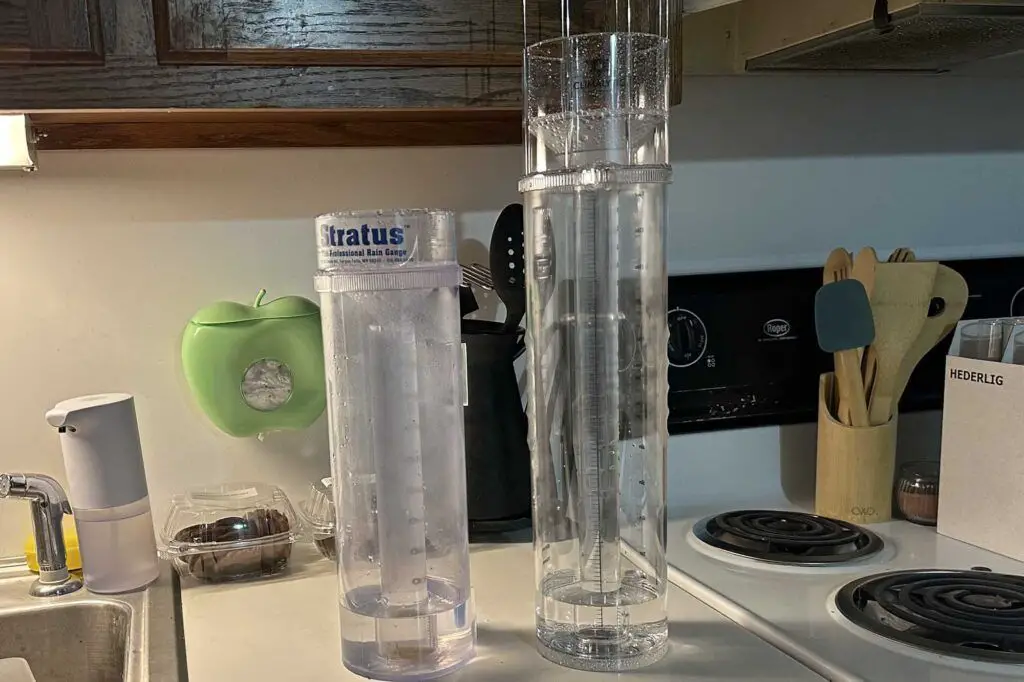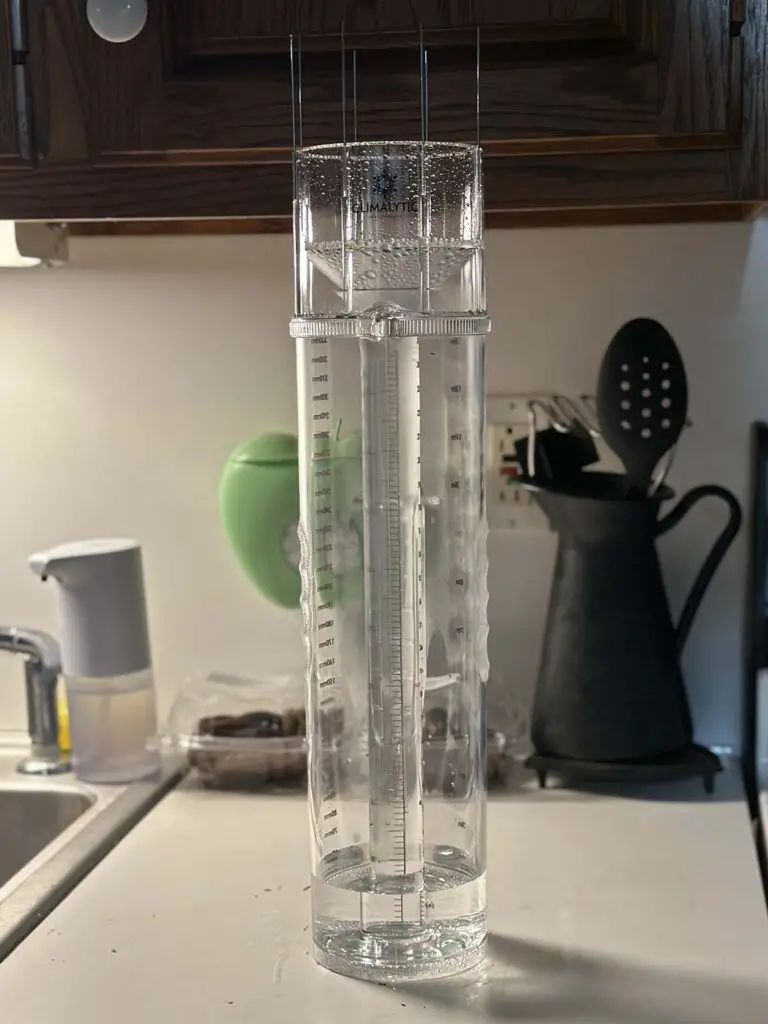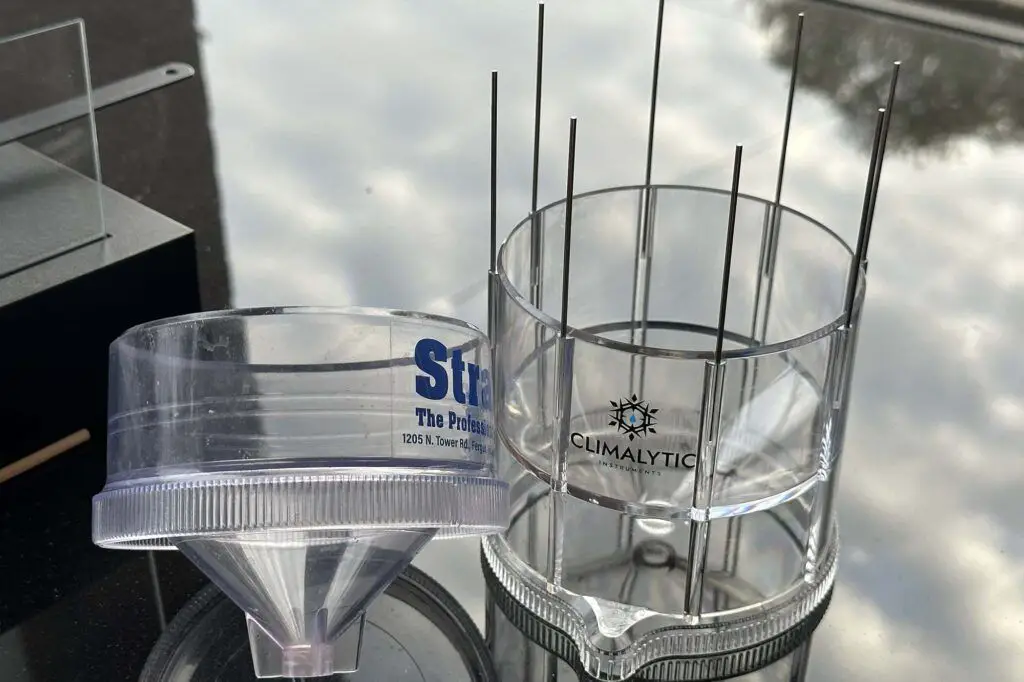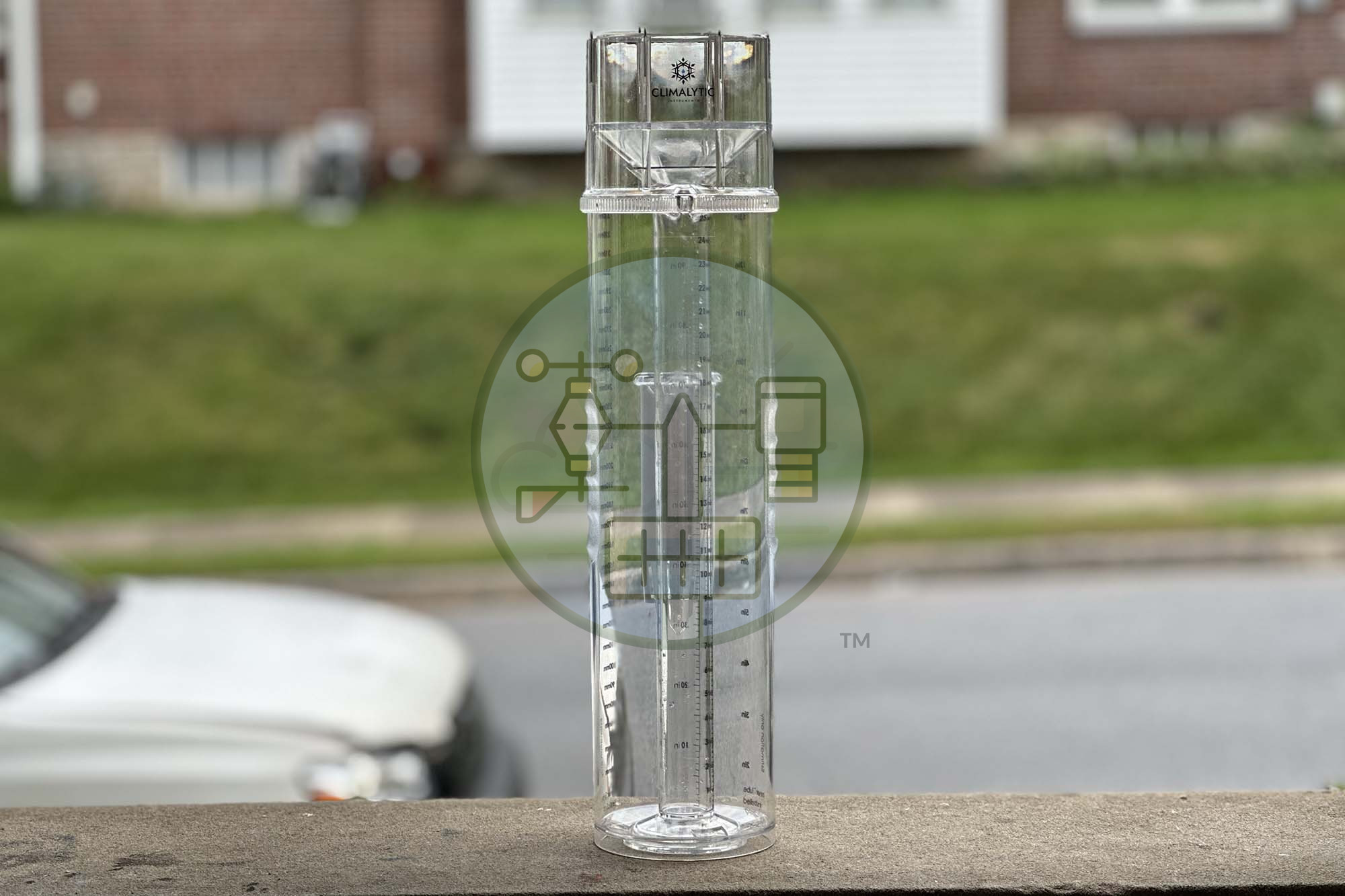You may not know this, but the Stratus is a rain gauge that is over 50 years old. While the design of rain gauges has remained essentially unchanged for hundreds of years, significant advancements have been made in accurately measuring precipitation across a wide range of conditions. The TROPO by Climalytic Instruments represents those advancements.
Now, our preferred rain gauge, the TROPO, features a steeper funnel, which has been shown to measure precipitation in wind more accurately. The overall gauge is larger and has a 13.5-inch capacity, making the inner cylinder much easier to read than the Stratus. Optional bird spikes keep your feathered friends from relieving themselves in the rain gauge, and textured grips on either side make transport much less risky.
However, that’s not all — the TROPO also features a handle and spout on the outer cylinder, making it simple to measure heavier rainstorms (a feature not found on the Stratus). We’re huge fans, and we recommend accuracy-conscious weather watchers consider the TROPO first.
Through our sister brand Cirrusly Weather, we are now an authorized reseller of the TROPO!
While weather gadgets don’t have the upgrade cycle of an iPhone, manufacturers improve their products frequently to get you to part with your hard-earned money. This is why I initially said, “Yeah, okay,” when Climalytic Instruments pitched us on the TROPO Precipitation Gauge in the summer of 2023. It’s a rain gauge. Can you improve on such an essential weather instrument?
Then, I learned a few things I didn’t know. The Stratus Precision Rain Gauge is over five decades old. While much more accurate than other rain gauge designs, the Stratus design isn’t perfect, resulting in slight but built-in inaccuracy. While rain gauges don’t need to change much, there have been some advancements in rain gauge designs over the past half-century.
With this in mind, Colorado-based meteorologist Tye Parzybok set out to create a rain gauge that is not only more accurate but also designed to address some of the annoyances weather observers experience with both the Stratus and other dual-cylinder gauges. It sounds like a fool’s errand, but they’ve done both.
And the best news over the past two years is a significant price drop. At launch in the summer of 2023, it retailed for $99, which is astronomical for a rain gauge. But it was such a massive success that those early adopters gave Climalytic some financial runway to drop the price to $66 on Amazon, a drop of a third during a period when many things have gone up by a similar amount.
While still more expensive than the classic Stratus, spending the extra few bucks is worth it for its primary target audience (CoCoRAHS and accuracy-conscious weather watchers).

Before diving into the review, I assume most want to know the difference between the two upfront. Both use a dual-cylinder design to first capture rainfall in the inner cylinder and then collect any additional rain in the larger outer cylinder. However, the TROPO is significantly larger, with a 13.5-inch capacity vs. 11 inches for the Stratus.
While 99% of us will never need that capacity, increasing that also makes the inner cylinder larger. While the TROPO’s inner cylinder still measures just the first inch that falls, the larger size of the cylinder spreads the measurement hash marks apart on the wall, making it easier to read. While I never had significant issues reading measurements, I could see where those with vision problems might have had some difficulty.
There are also a host of what I’d call “convenience features,” all aimed at making the gauge much easier to use than its predecessor. It’s here that the TROPO really sets itself apart and makes a stronger case for the premium price tag.

Setting Up and Using the TROPO Precipitation Gauge
Climalytic includes a vertical surface mount on which the TROPO can be slid during measurements. To ensure the most optimal readings, we recommend following our installation guide for weather stations. But inside the box, you’ll find the surface mount and a handle. This slides into the exact spot where you mount the gauge.
But that’s not all: the outer gauge has a second surprise: a spout. For anyone who’s used the Stratus, you’ll think this is brilliant. The former prevents the cylinder from slipping out of your hand during transport or pouring, and the latter ensures the water makes it into your inner cylinder rather than on your kitchen counter.
Don’t want to use the handle? The TROPO has textured grips placed in the middle of the gauge, which work just as well.
Most aren’t ready for the weight of a couple of inches of water (that gallon jug of spring water gives you an idea). In the heaviest rainstorms, measurements with the Stratus are a two-person job: one person holds the outer cylinder with both hands, and the other ensures the inner cylinder doesn’t tip over as you pour it in. We were lucky enough to have a torrential rainstorm during the test, allowing us to experience just how easy (and a one-person job) it is to take measurements using the handle and spout features of the TROPO.
I also appreciated the addition of bird spikes to the gauge cap. Without regular cleaning, the Stratus becomes a bird toilet, and the spikes positioned closely around the funnel’s rim will prevent any issues. Our TROPO was outside for the test for an entire week, and it returned completely clean—something that would never happen with the Stratus.

The Tons of Minor Enhancements All Add Up
Much of the rest of what the TROPO offers over the Stratus is far less significant, but these differences further distinguish it from other dual-cylinder rain gauges. For example, the funnel walls are much steeper than the Stratus’s, which, in theory, should improve the capture of rainfall in windy conditions. The funnel also ‘snaps’ on to prevent blow-offs, a known issue for the Stratus in extremely windy weather.
The outer cylinder also features indentations on the bottom, which allow you to secure the inner cylinder better after measurements. With the Stratus, there’s nothing on the bottom to keep it from moving around. Often, I’d find myself just trying to place it as best as I could and quickly putting the cap on. Sometimes, that would work, nudge the inner cylinder into place if necessary—but not always.
Then, there’s the gauge’s actual construction. Climalytic decided to use polycarbonate, which features better UV and weather resistance. It’s also more durable because weakened plastic can crack if the temperature changes drastically or if water freezes inside the tube. While the Stratus is also made of polycarbonate, we’ve found that over time, it becomes cloudy, much like traditional plastic would.

Accuracy
The above functionality wouldn’t matter much if the TROPO weren’t more accurate than the Stratus. In our tests, the measurements from a multi-day rainstorm were similar, but the TROPO measured .01″ less at -2.43″ vs. 2.44″. That is to be expected, as the studies have shown that the Stratus overmeasures rainfall by approximately 2.5%. Here, the difference is minuscule — just .4% — but others with more long-term experience reported similar results, with the Stratus overmeasuring about .03″ for every inch of rainfall measured.
Now, in fairness, there is also a margin of error that you must deal with in the actual measurement process. As I stated at the beginning, the Stratus isn’t as easy to read as the TROPO, so there’s a non-zero chance I may have misread the Stratus, and the actual difference is more significant. Some changes in the TROPO are also aimed at eliminating human error.
Final Thoughts
The TROPO is not a consumer rain gauge, nor is it intended to be. It’s every bit a precision meteorological instrument, designed by a meteorologist whose scientific focus has been on gathering precise precipitation data for much of his career (and one of the first CoCoRAHS observers, too). With the price break, though, those opting for the Stratus should choose the TROPO.
We’d still recommend the Stratus Rain Gauge above any store-bought rain gauge, which is often wildly inaccurate. And CoCoRAHS says that you don’t have to buy the TROPO — the Stratus will meet their requirements for the foreseeable future.
That said, the convenience features sold me on the TROPO. The inventor participated in the program, as some of the “fixes” are common complaints about using the Stratus and taking weather observations. The changes to the design make it a more accurate gauge, and accuracy is something that most weather observers are concerned with for good reason.
If you have the money, the TROPO gets our full-throated endorsement. It’s that good.




